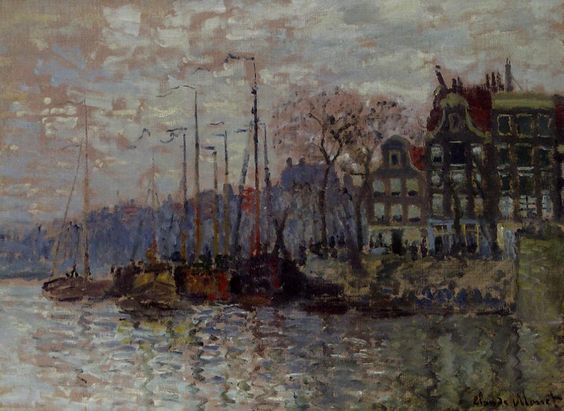Beschrijving
Claude Monet's painting "Amsterdam - 1874" is a work that encapsulates the aesthetic concerns and sensorial depth that characterize the Impressionist movement. Although this specific piece is not as well-known as other works in his vast output, it serves as a notable example of Monet's ability to capture light, atmosphere, and natural surroundings through his distinctive brushwork.
The composition presents an urban landscape, highlighting the canals and buildings typical of the period in Amsterdam. Water, a recurring element in Monet's work, reflects the sky and the buildings, creating a fascinating play of light and shadow. Monet's loose and energetic brushstrokes create a sense of immediacy and movement, inviting the viewer to experience the moment as the artist did. The way Monet uses color is essential to understanding the atmosphere of the work: a nuanced palette of blue and green tones that evoke both the freshness of the air and the calm of the waters.
In the central part of the painting, a series of boats can be seen, which are not merely decorative, but add a narrative about the daily life and maritime activity of the city. Although human figures are not prominently featured, the presence of these boats suggests a vibrant and interactive world, where people and environment coexist in harmony. This is typical of the Impressionist approach of suggesting rather than defining, allowing the viewer to complete the experience through their own imagination.
The use of light is another hallmark of Monet's technique; in this work, the luminosity reflects the atmospheric conditions of the area. Monet, known for his fascination with the effects of light, delves into the study of natural light, resulting in an almost ethereal atmosphere. This treatment of color and light may be reminiscent of works such as "Impression, soleil levant" which gave its name to the Impressionist movement, where capturing the moment is the primary focus.
The work is also representative of Monet's period when he was deeply influenced by his interest in plein-air painting, experimenting with the perception and interaction of the environment with light. In "Amsterdam - 1874", one senses the almost emotional connection that Monet has with the landscape, a recurring trait in his career that led him to explore the changes in nature throughout the seasons and the day. Through his works, Monet invites the viewer to a reflection on the transience of the moment, an idea that resonates throughout his artistic production.
However, "Amsterdam - 1874" may not be as celebrated as his other series, such as the Water Lilies or Rouen Cathedral, but it is no less interesting. It is a piece that reveals Monet's essential impulse to explore visual experience in an urban context, pushing the boundaries of traditional landscape painting of his time. Monet's work remains a testament not only to his individual talent, but also to the disruption and innovation that defined Impressionism as a revolution in the history of art.
Thus, when looking at "Amsterdam - 1874", we are reminded of the power of art to capture the essence of the moment, an ethos that Claude Monet cultivated throughout his career, reflecting not only the outside world, but also a deep connection with the human experience of seeing and feeling.
KUADROS ©, a famous painting on your wall.
Hand-made oil painting reproductions, with the quality of professional artists and the distinctive seal of KUADROS ©.
Painting reproduction service with satisfaction guarantee. If you are not completely satisfied with the replica of your painting, we will refund 100% of your money.

